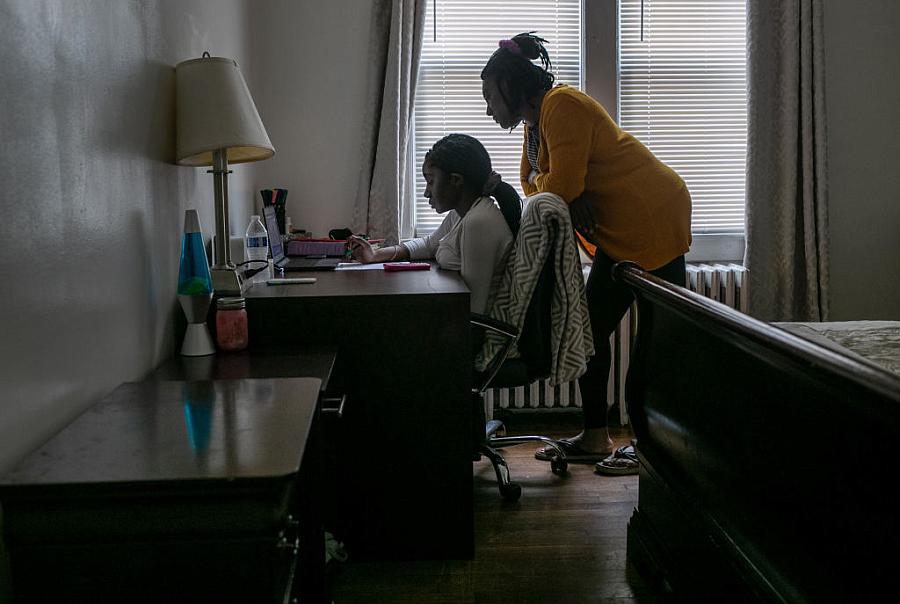The pandemic has been an unending disaster for women

Despite a full-time job, a mother of three named Janet has been responsible for all the pandemic parenting, helping her remote-schooling kids and watching a toddler all while working at home as a grant administrator.
Even on the days her husband pitched in, “it was total chaos,” with his impatience and frustration making things worse, said Prof. Jessica Calarco, an associate professor of sociology at Indiana University Bloomington who shared the experiences of Janet and other research study participants during the Center for Health Journalism’s recent “Covering Coronavirus: Women in Crisis” webinar.
Amid the stressors, Janet started drinking more heavily, gained 40 pounds and sunk into a deep depression. She lost her patience and yelled at her kids more, according to Calarco.
Her story is not unusual as women throughout the country disproportionately shoulder the burden of child care and remote schooling while working at home. At the same time, the pandemic has forced many women to leave the labor force in unprecedented numbers.
“Like Janet, many mothers have found themselves as the only parent in the household who is able to work from home, which has left them as the only one available to manage the added parenting responsibility when schools and childcares closed,” said Calarco. “That’s taking a significant toll on mothers’ well-being.”
Calarco joined C. Nicole Mason, president and chief executive officer of the Institute for Women’s Policy Research, and Maria Aspan, senior writer at Fortune, to discuss why these trends, the long-term consequences and how reporters can cover this crisis.
Mothers doing more
Before the pandemic, Calcarco and her team surveyed 250 Indiana moms to better understand the gaps between the expectations and reality of motherhood. When the pandemic began, the team expanded their research pool to explore its tremendous impact on mothers.
They found mothers, on average, were doing a disproportionate share of the pandemic parenting even when they were also working for pay. Many experienced worsening mental health outcomes as they stayed up to midnight or awoke at dawn to complete work. They were more tired than before, had less energy and many participants reported increased anxiety and depression.
Researchers wanted to understand why so many mothers were taking on more parenting responsibilities — at the expense of their careers and well-being — even when fathers were also working from home. Calarco’s team believes it’s deeply related to the “gendered structures of paid work,” such as pay inequality and entrenched policies that have pushed women to lower paid or part-time work.
During the pandemic, these preexisting inequalities became more apparent. For example, often the father was a higher earner, so protecting his job became the family’s priority, leaving mom to pick up the added burden.
Will policymakers respond?
Early last year, women’s policy expert Mason and her colleagues were celebrating an important milestone: Women made up 50% of the U.S. workforce.
“Just about two months later, when the pandemic hit, we saw all of the economic cleavages that were underneath those gains laid bare for us,” she said.
Stay-at-home orders devasted the service and leisure industries, which disproportionately employ women. Meanwhile, school closures forced women to make tough choices about their jobs and caretaking responsibilities. Women of color were especially impacted.
Future policy solutions need to focus on those most impacted by the pandemic: women, women of color and low-wage workers, Mason said. The women her organization surveyed said their most pressing needs were economic relief and health care measures – like access to affordable health insurance and paid sick leave. Advocates are also focusing on more long-term policy changes such as fixing a broken child care system and boosting the minimum wage.
Mason suggested that journalists explore how private employers are developing flexible workplace policies — or not. Journalists should also track what happens when women’s lost jobs aren’t restored, or when some women enter new fields altogether.
Other important questions Mason flagged: Who are the experts developing these policies? What’s the resistance to creating new policies? What will the new normal look like for women post-pandemic?
Exploring story ideas
The story of women leaving the labor force over the past year is incredibly complex, said journalist Maria Aspan, who has been covering the topic for Fortune.
“There’s not only one cause, which is part of what makes it such a rich and urgent story for journalists of all backgrounds and all beats to cover,” she said.
One way to approach the story is through policy angle, looking into how President Biden’s COVID-19 relief package would address the crisis and what it has abandoned — such as an increase in federal minimum wage.
There’s also the question of workplace safety: When will vaccinations allow women to safely return to work, especially in service jobs? And, there’s the business lens: What are big and small employers doing to address topics such as child care support, paid leave, and more flexible hours?
Another interesting topic is the role of child care centers, which not only help women with care needs but also employ women – and have been extraordinarily hard hit during the pandemic. The pending federal relief plan includes funding to prop up those centers.
Through her reporting, Aspan has interviewed many business executives who acknowledge the struggles their female employees face and show “a genuine desire to work on this.”
Mason, the policy expert, said the pandemic could spur deeper reform in the public sectors as well, creating the momentum for big changes such as universal affordable government subsidized childcare.
“This is the moment for us to really push, and go big and be innovative,” she said.
**
Watch the full presentation here:

